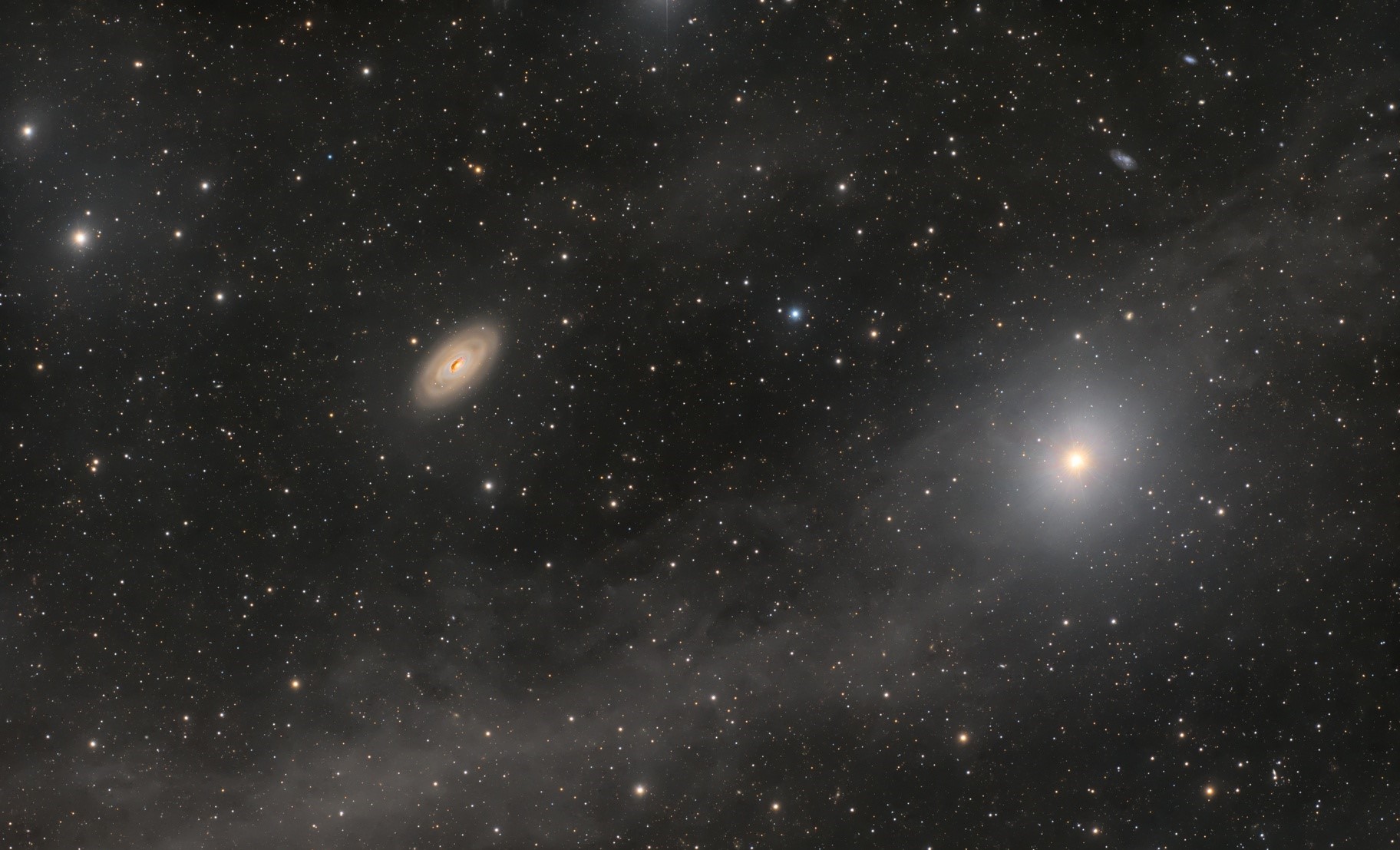
The Black Eye Galaxy, also known as Messier 64 (M64), is a stunning spiral galaxy located approximately 17 million light-years away from Earth in the constellation Coma Berenices. Named for its distinctive dark band of dust that appears to give it a “black eye”, this galaxy has long captivated astronomers and space enthusiasts alike. With its unique features and intriguing characteristics, exploring the Black Eye Galaxy unlocks a wealth of knowledge about the wonders of our universe. In this article, we will delve into 15 surprising facts about the Black Eye Galaxy, shedding light on its formation, structure, and the mysteries it holds. So, fasten your seatbelts and get ready for an extraordinary journey through the depths of space.
Key Takeaways:
- The Black Eye Galaxy (M64) is a captivating spiral galaxy with a dark band that gives it a unique “black eye” appearance, making it a favorite among amateur astronomers.
- This galaxy, located 24 million light-years away, has active star formation, a supermassive black hole, and intricate spiral arms, adding to its mysterious and dynamic nature.
Striking Appearance
The Black Eye Galaxy gets its name from the prominent dark band that crosses its bright center, resembling a black eye. This unique feature makes it visually distinct from other galaxies in the night sky.
Spiral Galaxy
M64 is classified as a spiral galaxy, with well-defined spiral arms extending from its nucleus. This classification puts it in the same category as famous galaxies like the Milky Way.
Mysterious Dark Band
The dark band that gives the Black Eye Galaxy its distinctive appearance is thought to be composed of dust and gas, which obstructs the light from the galaxy’s core. The exact cause of this feature is still being studied by astronomers.
Size and Distance
The Black Eye Galaxy is relatively large, spanning approximately 90,000 light-years in diameter. It is located around 24 million light-years away from Earth.
Active Galactic Nucleus
M64 is known for having an active galactic nucleus, indicating that there is a supermassive black hole at its center. This black hole is believed to be actively accreting matter and emitting powerful radiation.
Stellar Population
The Black Eye Galaxy has a diverse population of stars, including young hot stars that illuminate the spiral arms and older stars that populate the central bulge. This mix of stars adds to its captivating appearance.
Tidal Interaction
It is believed that the unique shape of the Black Eye Galaxy is a result of a past interaction with a smaller galaxy. This encounter likely caused the asymmetry in the outer regions of M64.
Active Star Formation
M64 exhibits active star formation within its spiral arms. Dense regions of gas and dust collapse under their own gravity, giving birth to new stars.
Spectacular Dust Lanes
The dust lanes seen in the Black Eye Galaxy are disarrayed and have intricate patterns. These dusty regions often host star-forming regions, where young stars are born.
Multiple Spiral Arms
M64 is known for its intricate spiral structure, with several spiral arms extending from its center. This pattern is a result of gravitational forces acting on the galactic material.
High Rotation Speed
The Black Eye Galaxy rotates at a high speed, with the outer regions spinning faster than expected. This rapid rotation contributes to the galaxy’s dynamic nature.
Halo of Globular Clusters
Surrounding the Black Eye Galaxy is a halo of globular clusters, which are gravitationally bound groups of stars. These clusters add to the galaxy’s overall stellar population.
Stellar Winds
The intense stellar winds from massive, young stars in the Black Eye Galaxy blow away surrounding gas and dust, shaping the galaxy’s structure and influencing star formation.
Active Radio Source
The supermassive black hole at the center of M64 emits strong radio waves, making it a notable radio source in the sky. This radiation is produced by the interaction of matter with the black hole’s intense gravitational field.
Amateur Observations
The Black Eye Galaxy is a favorite among amateur astronomers due to its prominent dark band and captivating appearance. Many enthusiasts have captured stunning images of this celestial beauty.
The Black Eye Galaxy (M64) is an extraordinary object in the universe, captivating us with its unique features and mysteries. Exploring its striking appearance, active star formation, and intriguing interactions provides us with a deeper understanding of the vast wonders present in our cosmos.
Conclusion
In this article, we’ve explored 15 surprising facts about the Black Eye Galaxy (M64). From its distinctive appearance to its unique characteristics, M64 continues to captivate astronomers and space enthusiasts alike. We’ve learned that M64 is known as the Black Eye Galaxy due to a dark band of cosmic dust swathing across its center, creating the illusion of a black eye. While initially unsettling, this feature makes M64 a striking object to observe in the night sky.Furthermore, we discovered that the Black Eye Galaxy is not just visually intriguing but also possesses a peculiar inner structure. Its inner region spins in the opposite direction of its outer region, a phenomenon that remains a puzzle for scientists.With its mysterious nature and captivating attributes, the Black Eye Galaxy serves as a reminder of the vastness and complexity of our universe. Exploring celestial wonders like M64 helps us gain a deeper understanding of the cosmos and our place within it.
FAQs
1. How far is the Black Eye Galaxy from Earth?
The Black Eye Galaxy is located approximately 24 million light-years away from Earth.
2. Is the Black Eye Galaxy visible to the naked eye?
No, the Black Eye Galaxy is not visible to the naked eye. It requires a telescope to observe it due to its distance.
3. How did the Black Eye Galaxy get its distinctive name?
The Black Eye Galaxy earned its name because of the dark band of cosmic dust that forms a resemblance to a black eye in its center.
4. What is the size of the Black Eye Galaxy?
The Black Eye Galaxy has a diameter of about 90,000 light-years, making it slightly smaller than our Milky Way galaxy.
5. What makes the Black Eye Galaxy unique?
M64 is unique because of its peculiar inner structure. Its inner region rotates in the opposite direction of its outer region, which is still not fully understood by scientists.
6. Can I see the Black Eye Galaxy with a small telescope?
Yes, the Black Eye Galaxy can be observed with a small telescope. However, larger telescopes will provide a more detailed and enhanced view of this intriguing galaxy.
7. Are there any other galaxies similar to the Black Eye Galaxy?
Yes, there are other spiral galaxies with similar features to the Black Eye Galaxy, such as the Sombrero Galaxy (M104) and the Ring Nebula (M57). Each of these galaxies exhibits its own unique characteristics.
8. Can we see any stars in the Black Eye Galaxy?
Yes, the Black Eye Galaxy contains billions of stars within its spiral arms, but they are not individually visible from our perspective without the aid of powerful telescopes.
9. Can the Black Eye Galaxy collide with the Milky Way?
The chances of the Black Eye Galaxy colliding with the Milky Way are incredibly slim. The vast distances between galaxies make such collisions rare events.
10. Are there any ongoing studies or missions focused on the Black Eye Galaxy?
Yes, several studies and missions have been conducted to study the Black Eye Galaxy. These observations aim to deepen our understanding of its peculiar structure and provide insights into galaxy evolution.
The Black Eye Galaxy's captivating beauty is just one example of the awe-inspiring wonders waiting to be discovered in our vast universe. Embark on a thrilling journey through space exploration, where groundbreaking discoveries await at every turn. Capture breathtaking images of celestial marvels with the art of astrophotography, revealing the intricate details and hidden secrets of the cosmos. Dive deeper into the mysteries of the universe by exploring the fascinating realm of galaxies, each with its own unique characteristics and stories to tell.
Was this page helpful?
Our commitment to delivering trustworthy and engaging content is at the heart of what we do. Each fact on our site is contributed by real users like you, bringing a wealth of diverse insights and information. To ensure the highest standards of accuracy and reliability, our dedicated editors meticulously review each submission. This process guarantees that the facts we share are not only fascinating but also credible. Trust in our commitment to quality and authenticity as you explore and learn with us.


